
An alcopop is any of certain flavored alcoholic beverages with relatively low alcohol content, including:
- Malt beverages to which various fruit juices or other flavorings have been added
- Wine coolers: beverages containing wine to which ingredients such as fruit juice or other flavorings have been added
- Mixed drinks containing distilled alcohol and sweet liquids such as fruit juices or other flavourings

Coca-Cola, or Coke, is a carbonated soft drink manufactured by the Coca-Cola Company. Originally marketed as a temperance drink and intended as a patent medicine, it was invented in the late 19th century by John Stith Pemberton in Atlanta, Georgia. In 1888 Pemberton sold Coca-Cola's ownership rights to Asa Griggs Candler, a businessman, whose marketing tactics led Coca-Cola to its dominance of the global soft-drink market throughout the 20th and 21st century. The drink's name refers to two of its original ingredients: coca leaves, and kola nuts. The current formula of Coca-Cola remains a closely guarded trade secret; however, a variety of reported recipes and experimental recreations have been published. The secrecy around the formula has been used by Coca-Cola in its marketing as only a handful of anonymous employees know the formula. The drink has inspired imitators and created a whole classification of soft drink: colas.

Cola is a carbonated soft drink flavored with vanilla, cinnamon, citrus oils and other flavorings. Cola became popular worldwide after pharmacist John Pemberton invented Coca-Cola, a trademarked brand, in 1886, which was later imitated by other manufacturers. Most colas contain caffeine, which was originally sourced from the kola nut, leading to the drink's name, though other sources are now also used. The original cola drink by Pemberton contained an extract from the coca plant as well. His non-alcoholic recipe was inspired by the coca wine of pharmacist Angelo Mariani, created in 1863.

Moxie is a brand of carbonated beverage that is among the first mass-produced soft drinks in the United States. It was created around 1876 by Augustin Thompson as a patent medicine called "Moxie Nerve Food" and was produced in Lowell, Massachusetts. The sweet soda is similar to root beer, with a bitter aftertaste. It is flavored with gentian root extract, an extremely bitter substance commonly used in herbal medicine.

John Stith Pemberton was an American pharmacist and Confederate States Army veteran who is best known as the inventor of Coca-Cola. In May 1886, he developed an early version of a beverage that would later become Coca-Cola, but sold his rights to the drink shortly before his death.
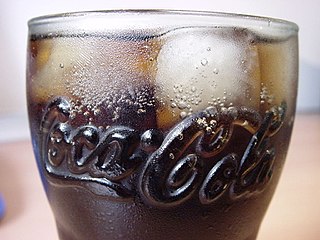
The Coca-Cola Company's formula for Coca-Cola syrup, which bottlers combine with carbonated water to create the company's flagship cola soft drink, is a closely guarded trade secret. Company founder Asa Candler initiated the veil of secrecy that surrounds the formula in 1891 as a publicity, marketing, and intellectual property protection strategy. While several recipes, each purporting to be the authentic formula, have been published, the company maintains that the actual formula remains a secret, known only to a very few select employees.
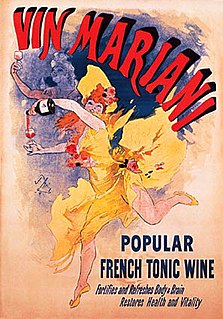
Coca wine is an alcoholic beverage combining wine with cocaine. One popular brand was Vin Mariani, developed in 1863 by French-Corsican chemist and entrepreneur Angelo Mariani.

Vin Mariani was a coca wine and patent medicine created in the 1860s by Angelo Mariani, a French chemist from the island of Corsica. Mariani became intrigued with coca and its medical and economic potential after reading Paolo Mantegazza's paper on the effects of coca. Between 1863 and 1868 Mariani started marketing a coca wine called Vin Tonique Mariani which was made from Bordeaux wine and coca leaves.
The cola wars refer to the long-time rivalry between soft drink producers The Coca-Cola Company and PepsiCo, who have engaged in mutually-targeted marketing campaigns for the direct competition between each company's product lines, especially their flagship colas, Coca-Cola and Pepsi. Beginning in the late 1970s and into the 1980s, the competition escalated, which gave this cultural phenomenon its current moniker of cola wars.
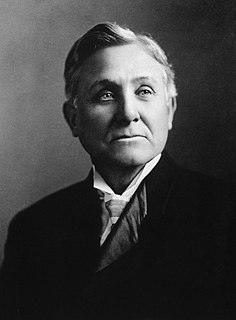
Asa Griggs Candler was an American business tycoon and politician who in 1888 purchased the Coca-Cola recipe for $238.98 from chemist John Stith Pemberton in Atlanta, Georgia. Candler founded The Coca-Cola Company in 1892 and developed it as a major company.

Fresca is a grapefruit-flavored citrus soft drink created by The Coca-Cola Company. Borrowing the word Fresca from Spanish, Italian and Portuguese, it was first introduced in the United States in 1966. Originally a bottled sugar-free diet soda, sugar sweetened versions were introduced in some markets.
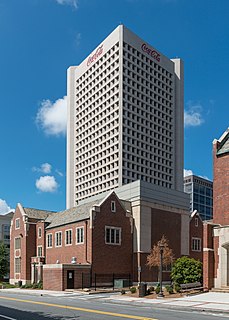
The Coca-Cola Company is a multinational beverage corporation incorporated under Delaware's General Corporation Law and headquartered in Atlanta, Georgia. The Coca-Cola Company has interests in the manufacturing, retailing, and marketing of non-alcoholic beverage concentrates and syrups, and alcoholic beverages. The company produces Coca-Cola, the sugary drink it is best known for, invented in 1886 by pharmacist John Stith Pemberton. At the time, the product was made with coca leaves, which added an amount of cocaine to the drink, and with kola nuts, which added caffeine, so that the coca and the kola together provided a stimulative effect. This stimulative effect is the reason the drink was sold to the public as a healthy "tonic", and the coca and the kola are also the source of the name of the product and of the company. In 1889, the formula and brand were sold for $2,300 to Asa Griggs Candler, who incorporated the Coca-Cola Company in Atlanta in 1892.

Cocaethylene (ethylbenzoylecgonine) is the ethyl ester of benzoylecgonine. It is structurally similar to cocaine, which is the methyl ester of benzoylecgonine. Cocaethylene is formed by the liver when cocaine and ethanol coexist in the blood. In 1885, cocaethylene was first synthesized, and in 1979, cocaethylene's side effects were discovered.

Coca tea, also called mate de coca, is an herbal tea (infusion) made using the raw or dried leaves of the coca plant, which is native to South America. It is made either by submerging the coca leaf or dipping a tea bag in hot water. The tea is most commonly consumed in the Andes mountain range, particularly Argentina, Bolivia, Colombia, Ecuador and especially in Peru, where it is consumed all around the country. It is greenish yellow in color and has a mild bitter flavor similar to green tea with a more organic sweetness.
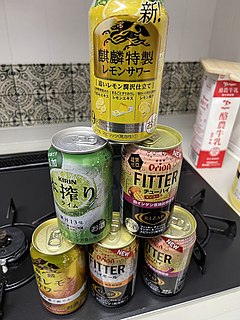
Chūhai, often sold as Chu-Hi as a canned drink, is an alcoholic drink originating from Japan. The name chūhai is an abbreviation of "shōchū highball" (焼酎ハイボール). Traditional chūhai is made with Barley shōchū and carbonated water flavored with lemon, though some modern commercial variants use vodka in place of shōchū. The flavors available have recently multiplied, including lime, grapefruit, apple, orange, pineapple, grape, kyoho grape, kiwi, ume, yuzu, lychee, peach, strawberry cream, and cream soda.
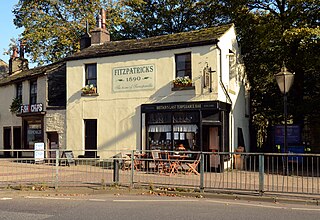
A temperance bar, also known as an alcohol-free bar, sober bar, or dry bar, is a type of bar that does not serve alcoholic beverages. An alcohol-free bar can be a business establishment or located in a non-business environment or event, such as at a wedding. Alcohol-free bars typically serve non-alcoholic beverages, such as non-alcoholic cocktails known as mocktails, alcohol-free beer or low-alcohol beer, alcohol-free wine, juice, soft drinks and water. Popular temperance drinks include cream soda, dandelion and burdock, sarsaparilla, and Vimto, among others. Various foods may also be served.
Coca may refer to any of the four cultivated plants which belong to the family Erythroxylaceae.

Frank Mason Robinson was an important early marketer and advertiser of what became known as Coca-Cola.
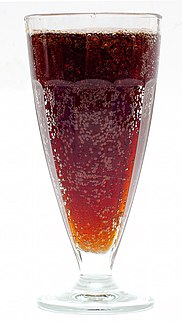
Baikal is a Russian non-alcoholic beverage of dark-brown colour. The beverage's basis is water, but it also contains extracts of natural herbs, sugar, citric acid, carbon dioxide. Ingredients include black tea extract, Eleutherococcus senticosus, cardamom oil, eucalyptus oil, lemon oil, licorice, St. John's wort and laurel.
















